|
HinduismCopyright © 1990/2007 by Timothy Conway, Ph.D. Here are a wealth of prayers, mantras, vocabulary, insights and practices of the five main yogas or mârgas/paths of Hinduism, the most ancient of the extant faiths, the religion of some 800 million people in India and worldwide. In addition to sections presenting the profound Hindu psychology of liberation, the captions accompanying the images of the Divine personifications will clarify some of the complicated yet beautiful Hindu theology and mythology. I have concluded with a very substantial bibliography of general works on Hinduism, and specific works on the various Hindu scriptures and the saints and sages of past and present. A note on pronunciation: Sanskrit vowels are generally pronounced as in Italian. The "c" is always pronounced in Sanskrit language with a "ch" sound. The "r" in its Sanskrit vowel form is pronounced with a roll or flip of the tongue with a slight "i" sound after it (e.g., in the name Krshna or Rg Veda or the term Prakrti). Because of Internet formatting difficulties, I have not been able to create the dot over the "n" or under the "m" for the nasalized sound, as in Sâmkhya Yoga or the name of sage Shankara. Nor have I distinguished herein between the two Sanskrit sibilant sounds, the thinner "sh" (as in Shiva, Shankara, and klesha) and the thicker "sh" (as in Vishnu and Krshna). I have also not distinguished here between the retroflex and dental consonants (t, th, d, dh, n), the former pronounced with the tongue touching the roof of the mouth, the dentals pronounced with the tongue behind the upper teeth. * * * * * * * *
MANTRAS and PRAYERS
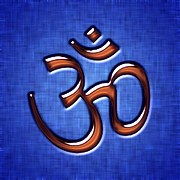
Om / Aum (the Name of the nameless Brahman or Absolute Divine Reality, the primordial vibration that the Divine Brahman freely emanates to manifest a multi-leveled cosmic appearance) --------- (The ancient Gâyatrî mantra, found in all four Vedas:) Om bhûr bhuvah svaha Om, O Supreme Lord of the 3 worlds (physical-astral-heavenly, or dense-subtle-causal). We worship That transcendent Lord Who embodies wisdom and light, Who removes all sins and ignorance. May this Divine One enlighten our intelligence. --------- (The mantra in Gâyatrî meter to Brahman/Absolute Reality, found in the medieval Mahânirvâna Tantra text:) Parameshvarâya vidmahe May we know the Supreme Being. Let us contemplate the Supreme Essence. And may that Brahman direct us. --------- (The mantra in Gâyatrî meter to the Divine Mother-Goddess [of various Names], in the Mahânirvâna Tantra:) Adyâyai vidmahe Let us ponder Adyâ (the primordial Goddess). Let us meditate on Parameshvarî, the Supreme Power. May Kâlî Mâ direct us. --------- Om tat Sat Om. (Glory to) That Absolute Truth/Being (Sat) --------- Om saccid ekam Brahma (Glory to) the One (ekam) Reality (Brahman), Absolute Being-Awareness (Sat Cit) --------- Om namah Shivâya (Praise to the Divine Lord Shiva; nama means "not me" [only Thee]) --------- Om namo Bhâgavate Vasudevâya (Praise to Lord Vishnu / Vasudeva) --------- Om namo Nârâyanâya (Praise to Vishnu as Nârâyana, God Incarnate as the human being) --------- Hare Krshna, Hare Krshna, Krshna Krshna, Hare Hare / Hare Râma, Hare Râma, Râma Râma, Hare Hare (--The “Mahâmantra”) (Praises to Krshna & Râma, the Incarnations or avatâras of Lord Vishnu) --------- Gurur Brahmâ Gurur Vishnuh, Gurur Devo Maheshvarah Obeisance to the blessed [Inner] Guru, who is truly Brahmâ [Divine Creator], Vishnu [Sustainer], Shiva [Dissolver, Liberator], and truly the Absolute [Parabrahman] revealing Its Reality. (From the Guru Gîtâ in the Skanda Purâna) --------- Om Asatomâ sad gamaya Om. From the unreal, lead us to Reality. From darkness, lead us to Light. From death, lead us to Immortality. Om—Peace, Peace, Peace. (A prayer from the most ancient of the Upanishad scriptures, the Brhadâranyaka Upanishad.) --------- Om pûrnamadah pûrnamidam Om. That (transcendent One) is Fullness (Pûrnam); This (immanent One) is Fullness; from That Fullness arises This Fullness; when This Fullness merges in That Fullness, That Fullness is all that remains. (A recurring hymn in the ancient Upanishad scriptures.) --------- Om tryambakam yajâmahe We worship the 3-eyed one (Lord Shiva), the fragrant, the increaser of growth; liberate us from death like the Uruvâka flower is liberated from its bondage; but do not separate us from immortality. --------- Om brahmâ'rpanam brahma havir Aham vaish'vârnaro bhûtvâ Brahman (Divine Reality) is the offering, the ritual, and the one who offers to the sacrificial fire, which is also Brahman. Seeing Brahman in every action, verily one realizes Brahman. // Becoming the digestive fire of life in the bodies of living creatures, and with the aid of the upward and downward breaths, I consume the four kinds of food. (--Prayer said before sacrificial offerings and meals, from the Bhagavad Gîtâ, 4:24 and 15:14) --------- Sarvam Idam Brahma(“All this is [truly] Brahman/Spiritual Reality”) --------- Loka samâstha sukhino bhavânthu May all beings in all the worlds be happy. ---------

In Hinduism, the Absolute God or Brahman, pure Spiritual Reality, is transpersonal, suprapersonal (not "impersonal"), and yet manifests on the personal level with a wide array of archetypes for the sake of anyone identified as a person and needing Divine help. Over time, the main Hindu schema that developed to represent these archetypal divine persons is the trimûrti or "three aspects/forms": Brahmâ, the creative aspect of God; Vishnu, the cosmic-sustaining aspect of God; and Shiva, the Divine dissolver/absorber of the cosmos. (Each has its female Divine power or consort--see below). For Shaivas (Shiva-worshippers), Shiva, "the Auspicious One," subsumes and becomes all three aspects as the Absolute Brahman ItSelf. (Vaishnavas make Lord Vishnu absolute in the same way.) Here Shiva is shown as the archetypal, liminal yogin, associated with the new moon (auspicious time for meditation), the nâgâ serpents (symbolizing wisdom), the damaru drum (sounding the cosmic rhythm), the conch shell (when blown makes the piercing sound awakening all beings from sleep), the trishula trident (symbolizing mastery over the three worlds [dense-subtle-causal], three times [past-present-future], and three gunas or qualities [harmony, agitation, inertia]), and the potent lingam, the "form of the formless," a symbol of Divine creativity and emanative power. Goddess Gangâ sits on his hair, bestowing the holy waters of the river named after her; Shiva's third eye suggests his omniscience. The three horizontal stripes on his forehead are made of ash, symbolizing the final inert state of all phenomena, and Divine changelessness. His right hand, palm forward, is in the classic abhaya mudra or gesture (mudra) of fearlessness. He wears necklaces and bracelets and holds a mala-rosary of empowering rudrâksha seeds ("tears of Rudra/Shiva," from the broadleaf evergreen tree of N. India). As Pâshupati, Lord of the animals, and beloved to all creatures, Shiva wears and sits on an animal skin (in this case a leopard skin, sometimes a tiger skin). Displayed in the background is the well-known yantra or visual diagram composed of a series of upward "male/Shiva" triangles and a series of downward "female/Shakti" triangles within concentric lotuses, the entire yantra symbolizing the Divine One and Its powers of emanation and dissolution. (Note: many Shaiva yogis will adopt some of the same elements as shown here, e.g., the ash, rudrâkshas, trident, animal skin, semi- or complete nudity, matted hair, etc.) Here below is a famous style of statue (developed by South India's Chola artists in the 9th century CE) displaying Shiva as Nâtarâja, Lord of the Dance. Standing atop the "personification of ignorant illusion," Shiva's upper right hand holds the damaru hand-drum, his other right hand displays the abhaya mudra. One of his left hands holds a flame. He is draped in serpents (wisdom) and surrounded by a ring of fire, suggesting either his dazzling radiance that ultimately dissolves all phenomena or else symbolizing the samsâra cycles of birth-death-rebirth. His matted locks (jatâ) whirl as he dances, and above his head sits a skull representing his triumph over death. The scenario rests upon a lotus pedestal, symbolizing Divine purity even while a world of change, limitation and evil manifests. The entire image suggests the incredibly dynamic yet absolutely serene nature of the Divine, whose rhythmic Bliss-Dance (Ânanda-tandava) pulsatingly conjures a cosmos in and out of appearance as a wondrous dream. Indeed, the image suggests Shiva's six activities: shrshti (creation, evolution); sthiti (preservation, support); samhara (destruction, mergence); tirobhava (concealment, illusion); udbhava (appearance) and anugraha (grace, release, liberation, attraction to the Divine).
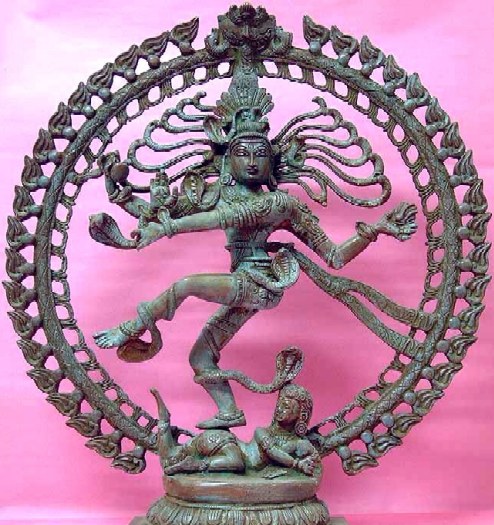
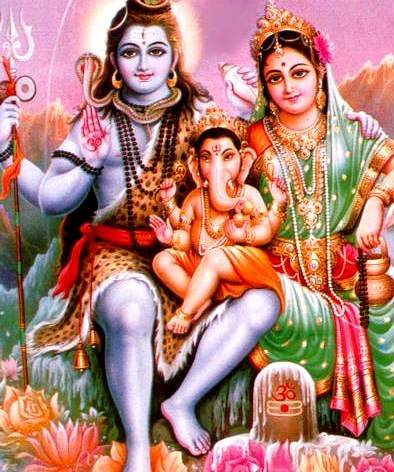
Lord Shiva with his "domesticating" consort Umâ-Pârvatî (Goddess Shakti/Devî personified) and one of their two sons, the elephant-headed Ganesha, a.k.a. Ganapathi-Gajanana-Vinâyaka (his elephant's head symbolizing intelligence, strength, loyalty). Not pictured here is Shiva and Pârvatî's other little son Shanmukhanâtha, a.k.a. Skanda-Subramâniam-Kârttikeya (who among the Tamils of South India is merged with their ancient beloved deity Murugan). Both Ganesha and Skanda are beloved gods of war who vanquish the "demons" or ego-tendencies. Ganesha is especially invoked by hundreds of millions of Hindus at the beginning of any endeavor for his capacity as Vighneshvara or Vighnarâja, Lord over obstacles. 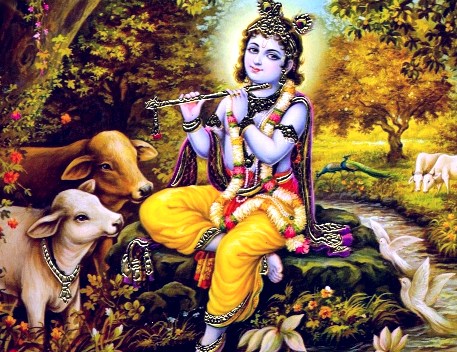
The delightful Lord Krshna, avatâra or Divine Incarnation of Lord Vishnu, sustainer of the cosmos, is shown in youth and later in life in the artistic images above and below. Krshna holds his famous murali flute, by which he makes such enchanting music as to awaken the soul from worldliness to Godliness. The flute also symbolizes the true devotee, who is so "empty" and "hollowed out" of egotism as to be a perfectly clear instrument for the Divine to manifest goodness and beauty within the world-dream.
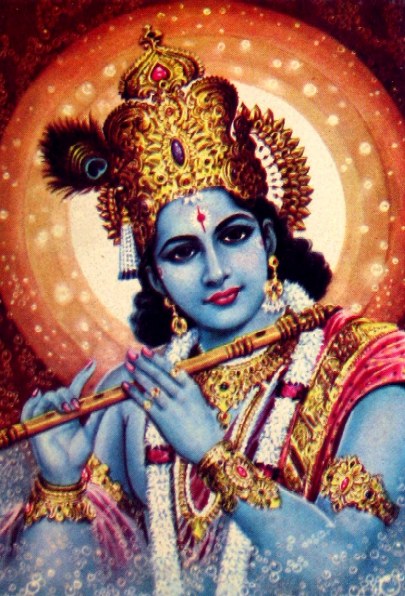
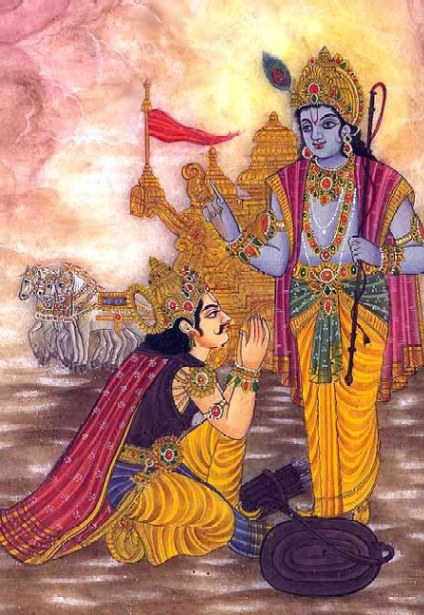
Lord Krshna (right) instructing his anguished kinsman and friend, the warrior Arjuna (left), to selflessly serve the Divine Plan by fighting alongside his four Pândava brothers against the evil Kaurava clan (destined to lose) in the fierce Kurukshetra battle over the north Indian kingdom, as told in India's ancient epic poem, the Mahâbhârata. Krshna's teachings on the yogas of nondual wisdom, desireless action, and devotion to Lord Vishnu, the Divine Self in all, are contained in the widely beloved text, the 700-verse Bhagavad Gîtâ or "Song of the Lord," which is embedded within Book VI of the Mahâbhârata poem.
HINDU SCRIPTURES Vedas. The most important and oldest Veda is the Rg Veda (c.1500-1200 BCE), followed by the supplementary Sâma Veda and two Yajur Vedas, and, later, the stranger, more motley Atharva Veda. Each Veda is traditionally divided into sections or stages known as Samhitâ, Brâhmana, Âranyaka, and, finally, Upanishad, the last two containing what many find as the greatest wisdom material in the Vedas. Major Upanishads--these number 13 or 16, depending on the schema, in addition to over 100 Minor Upanishads; all these are now available on the Internet in English translations at www.celextel.org. The Brhadâranyaka and Chândogya are the oldest, some 2,800 years old, comprising fully two-thirds of the material in the earliest, pre-Buddhist collection of Upanishads. They are followed by the Kena, Aitareya, Taittirîya, and Kaushîtakî Upanishads, all pre-Buddhist. Another group of Upanishads, less attached to the Vedic schools, more devotional, composed mainly in verse, using far less allegory and myth, and arising around the time of the Buddha (6th-5th century BCE) are the Katha, Mundaka, Shvetâshvatara, Îsha, and Nârâyana. A third group of Upanishads—the Prashna, Mândûkya, Maitrî, Jâbâla and Paingala—resume the prose style, but in a language resembling what we know as classical Sanskrit, distinguishable from the Vedic Sanskrit of earlier works. This group dates anywhere from the 5th century BCE to 1st century CE, with some passages being obvious additions made by later generations. (Note: the four Vedas including the Upanishad sections are considered Shruti, "that which is heard," i.e., Divinely revealed scripture.) Brahma Sûtras or Vedânta Sutras-- sage Bâdarâyana's terse synopsis of the essence of the older Upanishads. Bhagavad Gîtâ--Lord Krshna's instruction to kinsman Arjuna on the yogas of wisdom, devotion, and desireless action; the core of the Bhagavad Gîtâ may date to the 5th or 4th century BCE. This is surely the most widely read text in the Hindu world, and the subject of many commentaries. Mahâbhârata--the encyclopedic epic poem of ancient India in which the Bhagavad Gîtâ occurs; this long oral text began to be formed circa 400 BCE and was pretty much complete by 400 CE. Râmâyana--the long epic poem devoted to the saga of the noble prince Râma, his brothers, his wife Sîtâ, and Hanumân and demons including Râvana; this oral text was composed and edited around the same time as the Mahâbhârata, i.e., 400 BCE to 400 CE; a later, medieval vernacular rendering into Hindi by the poet-saint Tulasî Dâs would become very widely recited in North India. Purânas--long motley encyclopedic works on theology, rituals, vows, antics of the gods, demons, kings and sages; the usual schema holds that there are 18 major Purânas, most important of which is the beloved Bhâgavata Purâna (c.400 CE), which in its latter sections is devoted to the full story of Lord Krishna's life and exploits. Also widely-known are the Shiva Purâna, Skanda Purâna and Vishnu Purâna. (The Mahâbhârata, Râmâyana, and the Purânas are often called itihâsa ["so indeed it was"].) (All the above works save for the Vedas are considered smrti, "recollected scripture," derived from sruti "revealed scripture," or sometimes even regarded on the same level as sruti.) Works (commentaries, treatises and poems) of sage Shankara (c700 CE), founder of Advaita (nondual) Vedânta tradition, and works by later Vedânta acârya-teachers in Shankara's Advaita Vedânta line. Works by Râmânuja, Nimbârka, Mâdhva, Vallabhâ, Caitanya, et al., who established other, more dualistic Vedânta lineages, all devoted to worship of Lord Vishnu incarnate as Krshna. Yoga Vâsistha--a huge verse-text of delightful stories and potent nondual teachings on Divine Awareness as the only reality (at 32,000 couplet verses, this is one of the longest books in the pre-modern world). Ashtâvakra Gîtâ, Avadhûta Gîtâ, Ribhu Gîtâ--pithy and very "absolutist" late classical to early medieval works on nondual Awareness and Self-Realization. Tripura Rahasya--a medieval tantra-influenced text rather like the Yoga Vâsistha in presenting stories and penetrating nondual wisdom. Narada Bhakti Sûtras--a classic medieval text on devotion. Hindu Tantra-texts--these include "right-hand" texts like the Saundaryalaharî and "left-hand" texts such as the Mahânirvâna Tantra, Kulârnava Tantra, Rudrayâmala, Brahmâyâmala, Yoginî Tantra, Mantramahârnava, Mantramahodadhi. * * * * * * * * * Vedânta Schools: Advaita school: Shankara & Shankarâcâryas of 5 main maths (pronounced "mutts"): Sringeri, Kanchipuram, Dwaraka, Puri, Badrinath Vaishnava schools: Alvars of Tamilnadu; and schools founded by Râmânuja, Nimbârka, Mâdhva, Vallabhâ, and Caitanya (Caitanya's school is represented by the Goswamins of Bengal) Shaiva schools: Shaiva Siddhanta (Nayanar saints); Natha Shaivas (Gorakha); Lingâyat/Virashaivas of S. India (all these are generally dualistic); and the nondual Kashmir Trika Shaivism/Pratyabhijñâ * * * * * * * * * * NOTES ON HINDU PSYCHOLOGY In Indian philosophy, six major orthodox systems (darshanas, “views”) arose in the ancient times, along with several unorthodox systems. Three of these darshanas are especially relevant for a Hindu psychology--namely, the Vedânta schools (nondual and devotional), the Sâmkhya-Yoga school, and the Tantra schools. *** Some basic terms (most of these are from the Vedânta schools, based on the ancient Upanishads, Brahma-sûtra and Bhagavad Gîtâ; terms from the Sâmkhya-Yoga and Tantra traditions are singled out as such; more terms are given throughout and also listed toward the end of this handout): Brahman--Absolute Reality, which is both free of qualities, formless (nirguna) and also with qualities, “formful” (saguna). Âtman--the Supreme Spiritual God-Self, identical with Brahman. Jîvâtman--the separate ego-self-sense, not considered ultimately real by sages of the Advaita (nondualist) Vedânta school. Paramâtman--the Supreme Spiritual God-Self (a term used to insure the Absolute nature of the Âtman, since sometimes the latter term is used, especially by Buddhists, to denote the sense of individual ego-self). Saccidânanda--Absolute Being (Sat), Awareness (Cit), Bliss (Ânanda) (note that the letters change when the words are brought together, according to the Sanskrit language's "Samdhyâ" "joining" rules). Tat--“That,” the Supreme Reality. Paramârtha--Absolute Reality, Noumenon Vyavahâra--phenomenal manifestation, the “relative reality” of forms, which is a superimposition (adhyâsa) on Brahman Paramârthika-satya--the “ultimate truth,” the final level of discourse to refer to Absolute Reality. This Absolute truth-level is distinguished from the vyavahârika-satya or samvrti-satya, the pragmatic-conventional truth-level. (These are also distinguished as para-vidyâ and apara-vidyâ.) One's behavior must honor the conventional level of ethics and morality while inwardly one knows only the Absolute truth that God/Brahman alone IS. Mâyâ--the primal illusion-making or manifesting power of Brahman; it is beginningless and neither real nor unreal; mâyâ is the paradoxical aspect of saguna Brahman which conjures up the world appearance as a grand dream; mâyâ is not ultimately distinct from Brahman. Purusha--the Original, Eternal Self or "Person," pure Consciousness (a Sâmkhya-Yoga term). Prakrti--primal nature, the material principle, quite distinct from Purusha (in the Sâmkhya-Yoga view) and real in itself; it is comprised of the three gunas or qualities (of harmony, agitation, inertia--see below). (Note: in Advaita Vedânta, the terms “Purusha” and “prakrti” are adopted as synonyms for “Brahman” and “mâyâ” and are not considered ultimately distinct, prakrti considered to be only a dreamlike emanation or manifestation of the imperceptible Purusha or Âtman)
--------- *** An Advaita Vedânta 5-fold schema of personality sees the human being or any kind of sentient being as the jîva, the illusory individual or soul, comprised of the pañca koshas, the “5 sheaths”: 1) annamayakosha (the body built of food, the physical body) *** A 3-fold schema of personality overlapping the above is the tri-sarîra, 3 “bodies” schema: (Note: these 3 are sometimes also referred to as the three upâdhis or “bases”: sthûlopâdhi, sûksmopâdhi, & kâranopâdhi) Before/beyond the 5 koshas and 3 sarîras (i.e., the jîva or jîvâtman) is the Âtman or Paramâtman, the Supreme Spiritual Self, identical with Brahman or Parabrahman, the Absolute Divine Reality. In short, "the jîva is really Shiva."
*** Sometimes different “planes” or “realms” lokas are posited, which are corresponding “environments” for the different bodies: these are the bhûrloka (earth), bhuvarloka (the subtle planes or atmosphere), svarloka (the heavenly realm), maharloka, janarloka (these first five correspond to the five koshas), and then there are the highest lokas, sometimes known as tapoloka, satyaloka, siddhaloka, and brahmaloka. Below the earth-plane are various hells and nether regions; a total of 14 lokas are posited in all. *** Âtman pervades not only the 5 koshas and various lokas, but also the 3 avasthâs, the three main states of consciousness--the states of “waking” (jâgrat), dream (svapna), & dreamless sleep (sushupti). Turîya is the “fourth” so-called state of consciousness, actually the Witness aspect of Âtman that is aware of the rising, duration, and passing of the three states of consciousness. When one transcends even the witness state, abiding purely as formless Âtman/Brahman, one is said to be flourishing as turîyâtîta--“beyond the fourth.” --------- *** The 3 gunas are the three “fundamental qualities” which constitute prakrti / mâyâ; in their primordial state, they are perfectly balanced, and no world appearance is happening; according to Sâmkhya-Yoga philosophy, when their balance is “disturbed” in the beginningless beginning, a world-appearance arises and these 3 gunas govern the playing out of such a world: --sattva (sattoguna), the quality of harmony, equilibrium, peace, refinement; (Note: the gunas may characterize one's state of mind or body, the kind of food one eats, the kind of company one keeps, the kind of music one listens to, etc. Note further that in realization of the Âtman, one must transcend the influence of all these gunas, even sattoguna, and realize the state of gunâtîta, “beyond the gunas.” In other words, one must not be egocentrically identified with either the agitated or slothful mode, or even with the "saintly" sattva mode or attitude) --------- *** In Sâmkhya-Yoga philosophy/psychology, there are usually said to be 24 tattvas or principles constituting the subtle elements of prakrti, the principle of nature or energy-and-materiality: 1) avyakta: the unmanifest evolver of all things; also called mûlaprakrti, root-nature; from this comes... 2) buddhi: the intellectual faculty, higher mind, also sometimes called mahat, the Great One; from this issues, in turn,... 3) ahankâra: the notion of individuality, the self-sense or ego-sense 4) manas: lower mind (Note: manas, buddhi and ahankâra are collectively called the antarindriya or “inner organ.”) 5-9) the 5 tanmâtras: sound (sabda), touch (sparsha), sight (rûpa), taste (rasa), & smell (gandha) 10-14) the 5 buddhîndriyas, or sense organs: the ear, skin, eye, tongue, nose 15-19) the 5 karmendriyas, or organs of action: the voice, hand, foot, organ of excretion, organ of generation 20-24) the 5 mahâbhûtas or pañca bhûta (“5 elements”), which comprise the phenomenal world on subtle and gross/physical levels:
Before/beyond these constituent principles of inert Nature/Prakrti is the tattva-principle of Purusha, pure, uninvolved Spirit, the only principle of real sentience and awareness. Note, however, that the dualistic Sâmkhya metaphysical system reverses that of nondual Advaita Vedânta, which finds only one principle of sentience-awareness, the Purusha-Âtma-Self, witnessing and pervading the play of multiplicity. In Sâmkhya, by contrast, matter or prakrti is originally and ultimately only one single inert thing or principle, whereas the Purusha is actually multiple as a vast or infinite number of Purushas--a seemingly contradictory notion, since there is nothing to distinguish one purely spiritual, spaceless, timeless, structureless, changeless Purusha-"viewpoint" from another Purusha-viewpoint. Sâmkhya does not posit an overarching unifying principle. Îshvara "the Lord" is, for Sâmkhya, simply the one Purusha that is ever-free, never having mistakenly identified with the play of prakrti. ------------ The nondual Kashmir Shaiva tradition adds to these Sâmkhya tattva-principles 12 additional principles, including the immaterial, purely spiritual Divine tattvas: Shiva (pure Divinity), Shakti (this Divinity's non-separate Power or free intention to manifest a cosmos), Sadâshiva (Divinity with a sense of being and will), Îshvara (Divinity as Lord over a sense of an objective "This") and Shuddha Vidya ("Pure Intelligence," a Divine sense of the equality of subjective "I" and objective "This") (The concomitant Divine shaktis or powers are ânanda-bliss, icca-willpower, jñâna-wisdom, and kriyâ-action). The "impure" (ashuddha) tattvas are mâyâ-illusion and its five kañcuka-coverings--kalâ, limited power, vidyâ, limited knowledge, râga, passion for limited objects, kâla, limited time-sense, and niyati, limited sense of causation and space; this is followed by purusha, defined in Kashmir Shaivism as the "experiencer," and the 24 Sâmkhya tattvas from buddhi (higher mind) to prthivi-bhûta (earth).
--------- *** The 3 kinds of karma, “egocentric doing,” including one's actions and the consequences of one's actions, are: 1) sañcita karma, the accumulated storehouse of one's past actions and their effects, which have not yet manifested in one's life; (Note: upon becoming spiritually free, one has, by definition, ceased committing all kriyamâna/âgâmî selfish karma, Divine Grace has obviated all sañcita karma, and there remains only the playing out of one's prârabdha karma over the remainder of this life, though the realized one is not bothered by this dream-like manifestation of the old karma, perhaps not even aware of it at all, so absorbed is s/he in Saccidânanda--Absolute Being, Awareness, Bliss.) --------- *** 4 aims of life are considered appropriate in Hindu society: --------- *** 4 developmental stages of life (caturâsrama) are posited: --------- *** The 5 prânas or “life breaths” that work in our vital and nervous being: ~~~~~~~~~~~~~~~~~~~~~~~~~~~~~~~~~~~~
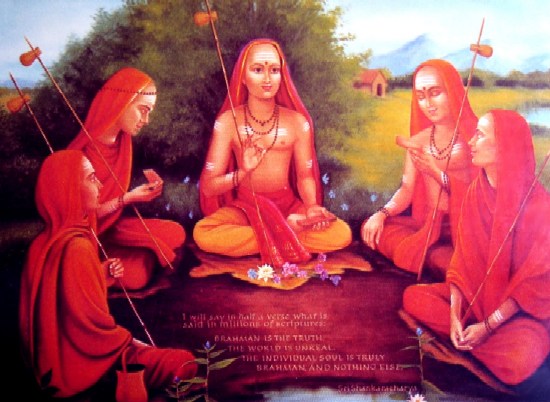
THE FIVE MAIN YOGAS Five basic yogas (ways of union) or mârgas (paths) have evolved over time in India. These five are 1) jñâna (wisdom), 2) bhakti (devotion), 3) karma or seva (service), 4) ashtânga (8-limbed) or râja (royal) way of mind-control, and 5) tantra (using forms & energy on the levels of body, speech and mind, specifically, mûdrâs/gestures, mantras/invocations, and mandalas/visualizations): I. The jñâna-mârga or way of penetrating wisdom is also known as the Advaita (nondual) Vedânta tradition, formulated by Shankara, c700 CE (pictured above, with disciples). In this way of spirituality, one simply listens to (sravana), reflects on (manana), and then meditates on (nidhidhyâsana) the teaching about our true Self (Âtman) being identical with the Absolute Reality (Brahman). This Divine Self-Reality is birthless, deathless, changeless, boundless, spaceless, timeless, and pure emptiness-fullness (empty of selfish ego, full as Being-Awareness-Bliss, Sat-Cit-Ânanda). The goal of this threefold discipline is sahaja-samâdhi, the “inborn, natural” state of utter nonduality, wherein one wakens to complete identity with the Absolute Reality (Brahman), both formless and “formful.” In the unconditioned condition sahaja-samâdhi there is complete eradication of the felt-sense of subject-object split, and such unenlightened reactions as fear, hate, greed, lust, etc. As prerequisites, one must have mastered the fourfold discipline, which involves the cultivation of 1) viveka (distinguishing the Real from the unreal, the changeless from the changing), 2) vairâgya (dispassion, freedom from desire), 3) mumukshatva (intense yearning for Realization), and 4) satkasampatti--the “six virtues”: inner control (sama), control of sense-organs (dama), fulfillment of one's duties (uparama), patient endurance of play of opposites (titiksâ), faith in the scriptures and one's guru (sraddhâ), and singleminded concentration on texts and guru's instruction (samâdhâna). There are four main mahâvakyas (great utterances) of the Upanishad texts, upon which the Advaita Vedânta aspirant can meditate, in addition to the teachings (upadesha) of the guru: --------- II. In the bhakti-mârga, or devotional path, of the more or less dualistic Vedânta schools, formulated by the ancient or early medieval sages Shândilya and Nârada, and by medieval saints Râmânuja, Râmânanda, Caitanya, Mâdhva, et al, there are various ways of schematizing the practices and stages of devotion to one's chosen form of the Beloved--one's ishta-devatâ. The main discipline or sâdhanâ is worship (upâsana) of one's Guru or one's Ishta-Devatâ (e.g., Lord Siva, Lord Visnu [or one of Visnu's âvatâras (incarnations) as Râma or Krishna], or the Devî [Divine Mother] under one of her forms, such as Durgâ, Kâlî, Laksmî, Sarasvatî, Chandî, Umâ, etc.). The worship can be done both inwardly (as honoring and remembering the Beloved) or outwardly, as pûjâ, ceremonial worship service. Other main practices include 1) japa (recitation of one's mantra, a sacred syllable or phrase such as “Om,” “Namah Shivâya,” “Shivoham,” “Soham,” “Om Namo Nârâyanâya,” “Om Namo Bhagavate Vasudevâya,” “Om Srî Râm Jaya Râm Jaya Jaya Râm,” or the Gâyatrî mantra); often this japa is done with a mala (rosary); 2) regularly keeping satsanga (company of the good); 3) bhajan / sankirtana (devotional singing); 4) dhyâna (meditation) on an image of one's Ishta-Devatâ or on a symbol like the Shiva-lingam or the saligram of Lord Vishnu; 5) listening (sravana) to the tales of the Lord's qualities or actions on behalf of sentient beings and to the heroic exploits of bhakta-saints as recounted in the scriptures (especially, the Bhâgavata Purâna and Bhagavad Gîtâ or Râmâyana); 6) reading the Bhakti Sûtras by sages Sândilya and Nârada; 7) doing service and charity on behalf of the Lord for sentient beings; etc. Nârada says that Bhakti manifests not only in the above-mentioned ways, but also as the loving attitudes toward God as a friend, son, spouse, child, and in the attitudes of complete surrender (saranâgati) to God, complete absorption in Him, and painful separation from Him. The bhakta (devotee) is blessed with darshan (sight) of the Lord, in dreams or visions, and ultimately comes to see the Lord as both completely transcendent and fully immanent in His creation, which is His lîlâ, His Divinely Playful expression in forms. --------- III. Karma- or seva-mârga's practice and theory are simple, as articulated by Lord Krishna in the Bhagavad Gîtâ: practice selfless service or the performance of one's societal duties without attachment to the fruits of one's actions (karmaphalatyâga)--this is desireless action (nishkâma karma). Karma yogins have the attitude of seeing all beings as the Âtma-Self (this is sarvâtmabhâva), and tend to also practice japa (mantra-recitation) and/or visualization of their chosen form of the Beloved (ishta-devatâ), and surrender to the Lord (Îshvarârpana) and His Divine Will while engaged in activity. From time to time they may perform (or have performed for them) yajñas (ritual sacrifices) to wash away the deleterious effect of their past actions and invoke Divine blessings. --------- IV. In the Sâmkhya-Yoga tradition, formulated by Patañjali as ashtânga-yoga (yoga of 8 limbs), also known as râja-yoga (“royal way of union”) one cultivates: Samâdhi can be “with seed of thought/image”--savikalpa, or “without seed”—nirvikalpa, pure consciousness alone). The highest samâdhi posited by Patañjali is the dharma-megha samâdhi, the “Cloud-of-Truth-Consciousness” (which is full and fruitful, like the rainclouds). --Note that the first 5 limbs (angas) of Patañjali's ashtânga-yoga are considered preparatory, “exterior limbs” (bahiranga), while the last 3 limbs (which collectively are known as samyama) comprise the antarangam, the “inner limbs” of yoga. --------- V. In the Tantra traditions of Hinduism, after preliminary purification, etc., one is to receive initiation (dîkshâ) from the guru, during which he recites a mantra into one's ear and bestows his life force or “divine power” on the sâdhaka (this empowerment is called saktipâta or gurukrpâ); one then practices recitation (japa) of one's mantra, does various visualizations and austerities (tapas), and, in the ritual circle (cakrârcana) with one's guru and other disciples, practices the “5 M's”--ritual eating of meat (mângsa), fish (matsya), parched grain (mudrâ), ritual drinking of wine (madya), and then, alone with one's consort (shakti), practice ritual coitus (maithuna). The actual use of the “5 M's” is only for those of the “hero” disposition (vira-bhâva), not for the “animal” character ( The ultimate ideal is to purify through breath-control (prânâyâma) and mind-control one's nâdîs, the pathways in the subtle body for one's subtle energy/life force, known in Tantra as the kundalinî-shakti. The most important nâdî is the sushumnâ (the central pathway running from the base of the spine to the crown of the head); next most important nâdîs are the îdâ and pingalâ nâdîs (on the left and right sides of the body, respectively, coiling around the sushumnâ, joining together at the lowest and highest points of the sushumnâ). There are 7 cakras, “wheels” or “centers” of energy, which run vertically along the sushumnâ, and through which the awakened or aroused kundalinî-shakti ascends (it is awakened through prânâyâma-breathing, asana-postures, mudrâ-gestures, meditation, devotion, and guru's mantra, touch, sight, or mere resolve). These 7 cakras are (from lowest to highest): (Note: each cakra is associated with a deity [deities], a bîja-mantra [seed syllable], a sound-pitch [vibration], a color, an element, a lotus of a certain number of petals, a number of qualities, etc.) When the kundalinî-shakti can flow freely up the sushumnâ through all the cakras and release at the sahasrâra (also known as the brahmarandhra), the aspirant becomes a siddha, accomplished one, attaining the highest state, asamprajñâta samâdhi, wherein all sense of separation has vanished and one awakens to complete identity with the Absolute, Divine Reality. [Note: a number of Advaita spiritual masters have affirmed that, after having experienced the kundalinî-shakti energy release at the sahasrâra-crown, which brings with it a state of formless consciousness (nirvikalpa samâdhi), one must allow the energy to “drop” to the Spiritual Heart, Hrdâya, corresponding to an area at the center or right-center of the chest, which allows one to abide in sahaja samâdhi, the “eyes open,” “natural oneness” of God-realization, wherein the experience of formless and formful Reality is balanced, one is perfectly free to experience either the formless or the play of forms.] ---------
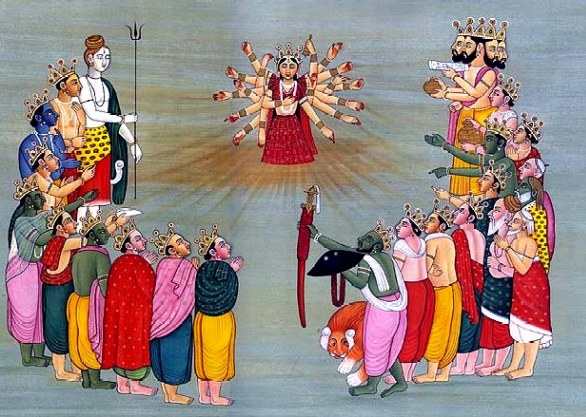
The Hindu trimûrti or "triple-aspect" Divinity usually emphasizes the male Divine forms of Brahmâ, Vishnu and Shiva, with their female Divine powers/consorts (Sarasvatî, goddess of arts and learning, Lakshmî, goddess of prosperity, and Umâ/Pârvatî, "domesticating" wife of the wild Divine yogi Shiva) celebrated more or less prominently depending on the needs and wants of devotees and spiritual aspirants. By early medieval India, however, a movement stemming from Tantra influence had swept through various regions of the subcontinent to honor the Supreme Goddess as Source of all Gods and gods. She is variously named and characterized, the name Devî being the most common. Her primary text is the Devî Mâhâtmya or Candi (c.500 CE), which is a "text within a text" embedded in the Mârkandeya Purâna. In the illustration above, Devî stands supreme, her multiple arms and paraphernalia suggesting her manifold Divine powers of salvation, with Shiva (on the left), the four-headed Brahmâ (on the right), Vishnu and his incarnations, and various sages and devotees shown gathered around in supplication. 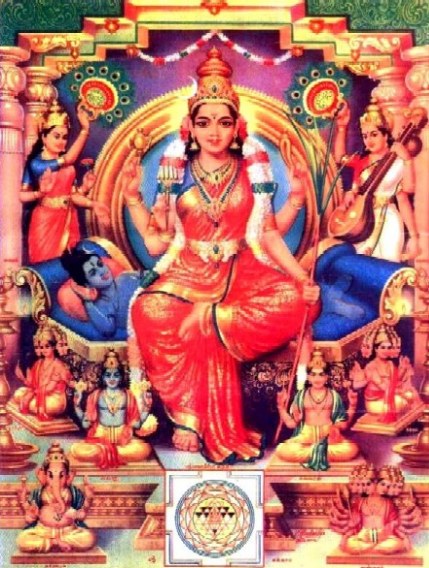
Here Devî is represented in a Shaiva context as Tripurâ Sundarî, Beautiful Goddess of the Three Worlds, an exalting of Umâ/Pârvatî. Her husband Shiva rests in the background. The two other Divine consorts--Sarasvatî, goddess of arts/learning, on the right, and Lakshmî, goddess of prosperity, on the left--stand in the background. A duplicate form of the four-headed Lord Brahmâ and Lord Vishnu sit on the left and right of her feet. Umâ Devî's two sons Ganesha (left) and the six-faced Shanmukhanâtha, a.k.a. Skanda-Subramâniam (right) are shown in the foreground, below her feet, flanking the Tantric Shrî Yantra cosmic diagram of downward and upward triangles. MORE TECHNICAL TERMS FROM THE HINDU TRADITION: avidyâ / ajñâna--ignorance of the Spiritual Reality; source of all problems. kleshas--misery and that which causes misery; a Yoga term referring to the 5 afflictions: ignorance (avidyâ), ego-sense (asmîtâ), the twin egocentric reactions of attraction and aversion (râga and dvesha), and attachment to life in the world (abhinivesha). samskâras / vâsanas--the conditioning tendencies or impulses or reactions of attraction and aversion; these can be innocent and “non-binding” (such as a musical talent or scientific aptitude or taste preference), but the terms are usually used in Hindu psychology to refer to the all-important “binding” (bandha hetu) samskâras /vâsanas which keep one obsessed by, fixated, “hung-up,” or caught in one's egocentric reactions of pulling at or pushing away various inner and outer experiences. citta-vrttis--the mind modifications which keep one distracted and unliberated (a Yoga term; citta-vrtti-nirodha is the cessation of these, and considered by Patañjali to be the essence of Yoga). granthis--the “knots” or blockages of energy in the psycho-physical make-up of the human being, caused by one's obsessions with worldly events. laya--a state of sleep or torpidity; an obstacle to real samâdhi (clear absorption). vikshepa--a state of distraction by ideas, memories, plans, etc. kasâya--a heavy attachment to a long forgotten experience. rasâsvâda--satisfaction over enjoyment of an inferior bliss state. sâdhanâ / yoga--spiritual discipline and “yoking” which brings God-union. sâdhakâ / yogin (fem.: yoginî)--the spiritual aspirant. abhyâsa--the effort made in one's sâdhanâ. sankalpa--resolve, determination, intention. siddhis--the paranormal powers of the siddha (adept), such as clairvoyance, precognition, knowing the minds of sentient beings, becoming invisible, creating “mind-made” bodies to bi-locate or multi-locate oneself, psychokinesis, materialization of objects, etc. moksha--liberation, release from the sense of separate selfhood and its various imperfections (the binding samskaras, the kleshas, etc.) jîvanmukta--one liberated while still alive with a physical body. jñâni--the one who knows (authentically, trans-conceptually) his Real Nature or Identity as the Absolute Being-Awareness-Bliss, the completely liberated sage. jñâna / brahma-vidyâ--the supreme wisdom or knowledge of the Absolute parabhakta--the realized one who worships God, fully knowing that God and he are not separate entities. guru—one “heavy” with knowledge; an alternate etymology is that the guru is the remover (gu) of (spiritual) darkness (ru). âcârya--spiritual preceptor (synonymous with guru). lîlâ--the Divine Play of God, who is “sporting” and “delighting” in/as the world of forms. A term used by some Vedântins (of nondual and devotional traditions) to describe the phenomenal appearance of the formless Noumenon.
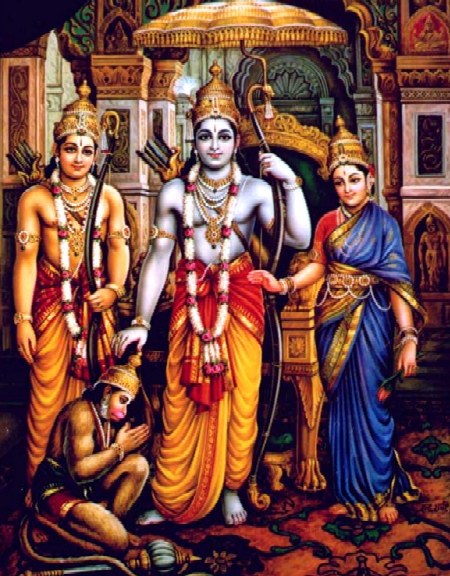
Lord Râma is shown after his coronation as rightful king, standing with his wife Sîtâ, his brother Lakshman, and Hanuman the monkey-king, his helpmate and devotee. The tale of Râma and his three brothers, his exile into the forest and adventures therein with Sîtâ and Lakshman, the abduction of Sîtâ by the demon Râvana, and the rescue of Sîtâ by Hanuman, Râma and Lakshman, is the subject of India's other major epic poem, the Râmâyana. In the later stages of this epic's composition, Râma is transformed into the seventh avatâra or Divine Incarnation of Lord Vishnu, almost equal in stature to Krshna, the eighth avatâra. Bibliographic References I. (General): Klaus Klostermaier, A Survey of Hinduism, Albany, NY: State Univ. of NY (SUNY) Press, 3rd ed., 2007. Krishna Sivaraman (Ed.), Hindu Spirituality: Vedas through Vedanta, NY: Continuum, 1989. Ainslie T. Embree (Ed.), The Hindu Tradition: Readings in Oriental Thought, NY: Random House Vintage Books ed., 1972. S. Radhakrishnan & Charles Moore (Eds.), A Sourcebook in Indian Philosophy, Princeton, NJ: Princeton Univ. Press, 1957. Ananda Coomaraswamy, Hinduism and Buddhism, NY: Philosophical Library, 1957 (reprint Munshiram Manoharlal, 1996); and The Dance of Siva, Bombay: Asia Publ. House, 1956. Diana Eck, Darsan: Seeing the Divine Image in India, NY: Columbia Univ. Press, 1996 (first publ. in 1985); and Banaras: City of Light, Princeton, NJ: Princeton Univ. Press, 1983. Alain Danielou, Hindu Polytheism, London: Routledge & Kegan Paul, 1963; and Yoga: The Method of Reintegration, NY: University Books, 1956. D.S. Sarma, Hinduism through the Ages, Bombay: Bharatiya Vidya Bhavan, rev. ed., 1958. S.N. Dasgupta, Hindu Mysticism, various reprints (first publ. in 1927). S.N. Dasgupta, History of Indian Philosophy, 5 vols., Delhi: Motilal Banarsidass ed., 1975 (first publ. in 1922). K.M. Sen, Hinduism, Baltimore, MD: Penguin, 1961. Karl Potter (Ed.), Advaita Vedanta up to Samkara and His Pupils, Princeton Univ. Press, 1981. Eliot Deutsch, Advaita Vedanta: A Philosophical Reconstruction, Honolulu: East-West Center / Univ. Press of Hawaii, 1969. Chandradhar Sharma, Indian Philosophy: A Critical Survey, NY: Barnes & Noble Amer. Ed., 1962. Eliade, Mircea, Yoga, immortality and freedom, Princeton, NJ: Princeton Univ. Press, Bollingen Series LVI, 2nd ed., 1969. J. Rudrappa, Kashmir Saivism, Mysore: Prasaranga Univ., 1969. Natalia Isayeva, From Early Vedanta to Kashmir Shaivism: Gaudapada, Bhartrhari, & Abhinavagupta, SUNY, 1995. Baljit Nath Pandit, Aspects of Kashmir Saivism, 1977, History of Kashmir Saivism, 1989 (both from Utpal Publications, Srinagar, Kashmir); and Specific Principles of Kashmir Saivism, Munshiram Manoharlal, 1997. Motilal Pandit, The Trika Saivism of Kashmir Munshiram Manoharlal, Munshiram Manoharlal, 2003. Navjivan Rastogi, The Krama Tantricism of Kashmir: Historical & General Sources, Motilal Banarsidass, 1979. Gavin Flood, Body & Cosmology in Kashmir Saivism, San Francisco: Mellen Research U. Press, 1993. Steven Jeffrey Kupetz, The Non-dualistic Philosophy of Kashmir Saivism: An Analysis of the Pratyabhijna School (Ph.D. Thesis, U. of Minnesota, 1972), Ann Arbor, MI: University Microfilms, 1976. Kamalakar Mishra, Kashmir Saivism: The Central Philosophy of Tantrism, Cambridge, MA: Rudra Press, 1993. Paul Murphy, Triadic Mysticism: The Mystical Theology of the Saivism of Kashmir, Motilal Banarsidass, 1986. Lakshmi Nidhi Sharma, Kashmir Saivism, Varanasi: Bharatiya Vidya Prakashan, 1972. See series of works on Kashmir Saivism from SUNY Press: Mark Dyczkowski, The Doctrine of Vibration: An Analysis of the Doctrines & Practices of Kashmir Shaivism, 1987; Dyczkowski, The Canon of the Saivagama & the Kubjika Tantras of the Western Kaula Tradition, 1988; Paul Eduardo Muller-Ortega, The Triadic Heart of Siva: Kaula Tantricism of Abhinavagupta in the Non-Dual Shaivism of Kashmir, 1989; Andre Padoux, Vac: The Concept of the Word in Selected Hindu Tantras (Jacques Gontier, Tr.), 1990; Deba Brata SenSharma, The Philosophy of Sadhana: With Special Reference to the Trika Philosophy of Kashmir, 1990; Lilian Silburn, Kundalini: The Energy of the Depths: A Comprehensive Study Based on the Scriptures of Nondualistic Kasmir Saivism (Jacques Gontier, Tr.), 1988. Georg Feuerstein, The Yoga Tradition: Its History, Literature, Philosophy and Practice, Prescott, AZ: Hohm Press, 1998/2001. David Kinsley, Hindu Goddesses: Visions of the Divine Feminine in the Hindu Religious Tradition, Berkeley: Univ. of California Press, 1986. Sudhir Kakar, Shamans, Mystics and Doctors: A Psychological Inquiry into India, and Its Healing Traditions, NY: Alfred Knopf, 1982. Robert E. Svoboda, Aghora: At the Left Hand of God and Aghora: Kundalini, Albuquerque, NM: Brotherhood of Life, 1986/1993. N.N. Bhattacharya, History of the Tantric Religion, 1982. Ajit Mookerjee & Madhu Khanna, The Tantric Way: Art, Science, Ritual, London: Thames & Hudson, 1977. M.P. Pandit, Gems from the Tantras, Madras: Ganesh, 1969. Agehananda Bharati, The Tantric Tradition, NY: Samuel Weiser rev. ed., 1975; and The Ochre Robe: An Autobiography, Garden City, NY Doubleday Anchor Books ed., 1970. John White (Ed.), Kundalini, Evolution, and Enlightenment, Garden City, NY: Doubleday Anchor Books ed., 1979.
II. (Individual Scriptures): Raimundo Panikkar, The Vedic Experience: Mantramanjari (An Anthology of the Vedas for Modern Man and Contemporary Celebration), Berkeley, CA: Univ. of California, 1977 (reprint: Motilal Banarsidass, 2001). William Mahony, The Artful Universe: An Introduction to the Vedic Religious Imagination, SUNY, 1998. Sarvapelli Radhakrishnan (Ed. & Tr.), The Principal Upanisads, NY: Harper & Brothers, 1953. Swami Nikhilananda (Ed. & Tr.), The Upanishads (abridged), NY: Harper & Row Torchbooks ed., 1964 (see also his 4-volume unabridged edition). Patrick Olivelle, Upanisads, London, UK: Oxford Univ. Press, 1996; and Samnyasa Upanisads: Hindu Scriptures on Asceticism and Renunciation, Oxford U. Press, 1992. Swami Madhavananda, (Tr.), Minor Upanisads, Calcutta: Advaita Ashrama, 1973. George Thibaut (Tr.), The Vedanta Sutras [Brahma Sutras] of Badarayana, with the Commentary by Sankara (2 Vols.), NY: Dover ed., 1962. Swami Vireswarananda (Tr.), Brahma-Sutras, Calcutta: Advaita Ashrama, 4th ed., 1970. Winthrop Sergeant, The Bhagavad Gita, SUNY Press, 1984. S. Radhakrishnan (Tr.), The Bhagavadgita, NY: Harper Torchbooks ed., 1971. Alladi Mahadeva Sastry (Tr.), The Bhagavad Gita, With the Commentary of Sri Sankaracharya, Madras: Samata Books, 7th ed., 1977. (Other translations of the Bhagavad Gita include those by Swami Nikhilananda, Swami Gambhirananda, Swami Chidbhavananda, Swami Tapasyananda, A.G.Krishna Warrier, et al.) Arvind Sharma, The Hindu Gita: Ancient and Classical Interpretations of the Bhagavadgita, LaSalle: Open Court, 1986. The Mahabharata (the definitive scholarly version is by J.A.B. Van Buitenen [Tr.], James Fitzgerald [Tr. & Ed.], et al., Mahabharata [multiple volumes, ongoing translation; Books 1-5 and 11-12 of the 18 books are in print], U. of Chicago Press, 1975 onward; see various other editions, such as those abridged and translated by Kamala Subramaniam, C. Rajagopalachari, et al.) The Ramayana (the definitive scholarly version is the translation project overseen by Robert Goldman [Tr. & Ed.] et al., The Ramayana of Valmiki [7 vols.], Princeton, NJ: Princeton U. Press, 1984 onward. See also Hari Prasad Shastri [Tr.], The Ramayana of Valmiki [3 vols.], London: Shanti Sadan, 1962; and J.L. Brockington, Righteous Rama: The Evolution of an Epic, Oxford U. Press, 1984. For various other editions, see translations by Kamala Subramaniam, Swami Venkatesananda, Hari Prasad Shastri, et al.) Christopher Key Chapple, Yoga and the Luminous: Patanjali's Spiritual Path to Freedom, SUNY, 2008 (translation and commentary on the Yoga Sutra). I.K. Taimni (Tr.), The Science of Yoga, Wheaton, IL: Quest Books, 4th ed., 1975 (transl. & commentary on the Yoga Sutra). Rammurti S. Mishra (Tr.), Yoga Sutras: The Textbook of Yoga Psychology, Garden City, NY: Doubleday Anchor Books, 1973. Georg Feuerstein (Tr.), The Yoga-Sutra of Patanjali: A New Translation and Commentary, NY: Inner Traditions, 1991. Swami Satchidananda (Tr.), Integral yoga: The Yoga-sutras of Patanjali, Pomfrey, CT: Integral Yoga Publications, 1978. Swami Prabhavananda (Tr.), Srimad Bhagavatam: The Wisdom of God, NY: Capricorn Books ed., 1968 (on the Bhagavata Purana). S.S. Cohen (Ed.), Srimad Bhagavata, Tiruvannamalai, S.India: Sri Ramanashram, 2nd ed., 1977. Daniel Sheridan, The Advaitic Theism of the Bhagavata Purana, Bombay: S. Asia Books, 1986. Swami Venkatesananda (Ed. & Tr.), Vasistha's Yoga, SUNY ed., 1993 (first publ. in 2 vols. in 1976). Swami Sri Ramanananda Saraswathi (Tr.), Tripura Rahasya: The Mystery Beyond the Trinity, Tiruvannamalia, S.India: Sri Ramanashram, 3rd ed., 1971. Radhakamal Mukerjee (Tr.), The Song of the Self Supreme: Astavakra Gita, Clearlake, CA: Dawn Horse Press, revised Amer. ed., 1982. Swami Nityaswarupananda (Tr.), Astavakra Samhita, Calcutta: Advaita Ashrama, 4th ed., 1975. Swami Chetanananda (Tr.), Avadhuta Gita: The Song of the Ever-Free, by Dattatreya Avadhuta, Calcutta: Advaita Ashrama, 1984. H. Ramamoorthy (Tr.), The Ribhu Gita [from the Sivarahasya], Santa Cruz, CA: Society of Abidance in Truth, 1995. N.R. Krishnamoorthi Aiyer (Ed. & Tr.), The Essence of Ribhu Gita, Tiruvannamalai, S. India: Sri Ramanashramam, 1985. Kaivalya Navaneeta (The Cream of Emancipation): An Ancient Tamil classic, by Tandavaraya Swami (Swami Ramanananda Saraswathi, Tr.), Tiruvannamalai, S. India: Sri Ramanasramam, 3rd ed., 1981. Swami Tyagisananda (Tr.), Narada Bhakti Sutras, Madras: Sri Ramakrishna Math, 1972. The Guru Gita (from the Skanda Purana) (Swami Narayananda, Tr.), Bombay: India Book House ed., 1976. Arthur Avalon (Ed. & Tr.), Tantra of the Great Liberation (Mahanirvana Tantra) , NY: Dover Publ. ed., 1972. M.P. Pandit (Tr.), Kularnava Tantra, Madras: Ganesh & Co., 2nd ed., 1973. Hans-Ulrich Reiker, (Tr. & Commentary), The yoga of light: Hatha yoga pradipika (Tr. by Elsy Becherer), L.A.: Dawn Horse, 1974.
III. (Books on/by Sages and Saints:) Sankara's works, especially his Upadesa Sahasri, Atmabodha: Self-Knowledge, Aparoksanubhuti: Self-Realization, Quintessence of Vedanta [Sarva Vedanta Siddhanta Sarasangraha] , and commentaries on Brahma [Vedanta] Sutras, Bhagavad Gita and various Upanishads; all these are published by the Vedanta / Advaita Ashrama / Ramakrishna presses, available from Vedanta Temple bookstores. (Other works ascribed to Sankara, such as the Crest-Jewel of Discrimination [Vivekachudamani], are most likely not by Sankara.) Cenkner, William, A Tradition of Teachers: Sankara and the Jagadgurus Today, Delhi: Motilal Banarsidass, 1983. Dharmaraja, Vedanta-paribhasa (Swami Madhavananda, Tr.), Belur Math, District Howrah: Ramakrishna Mission Saradapitha, 1963. Sadananda, Yogindra, Vedantasara: The essence of Vedanta. (Swami Nikhilananda, Tr.), Calcutta: Advaita Ashrama, 1978. Vidyaranya, Swami, Pancadasi (Swami Swahananda, Tr.), Madras: Sri Ramakrishna Math, 1975. Vidyaranya, Swami, Jivanmuktiviveka (Liberation in life) of Vidyaranya S. Subrahmanya Sastri & T.R. Srinivasa Ayyangar, Ed. & Tr.), Madras: The Adyar Library and Research Center, The Theosophical Society, 1978. Anantendra-Yati, Vedanta-sara-sangraha (Quintessence of Vedanta) (T.M.P. Mahadevan, Tr.), Madras: Ganesh and Co., 1973. Nakamura, Hajime, A History of Early Vedanta Philosophy (Trevor Leggett, Sengaku Mayeda, Taitetz Unno, et al, Tr.) (Part One), Delhi: Motilal Banarsidass, 1983. Aiyar, R. Krishnaswami (Ed.), Dialogues with the Guru: Talks with His Holiness Sri Candrasekhara Bharati Swaminath, late Shankaracharya of Sringeri Math, Bombay: Chetana Ltd., n.d. Sankaranarayanan, P., The Call of the Jagadguru: Discourses of His Holiness Sri Jagadguru Sri Candrasekharendra Sarasvati Sripadah of Kanci Kamakoti Pitham, Madras: Ganesh & Co., 1958. R.D. Ranade, Pathway to God in Kannada Literature, Bombay: Bharatiya Vidya Bhavan, 2nd ed., 1970. R.D. Ranade, Mysticism in India: The Poet-Saints of Maharashtra, SUNY ed., 1983 (originally publ. in 1933). Jnaneshvar / Jnanadeva, Bhavartha Dipika or Jnaneshwari (Ramchandra Keshav Bhagwat, Tr.), Madras: Samata Books, 1979/1954. S. Abhayananda, Jnaneshvar: The Life and Works of the Celebrated Thirteenth Century Indian Mystic-Poet, Olympia, WA: Atma Books, 1989 (available for free at the author's website: www.themysticsvision.com). B.P. Bahirat, The Philosophy of Jnanadeva: As Gleaned from the Amrtanubhava, Delhi: Motilal Banarsidass, 1956/1984. Savitribai Khanolkar, Saints of Maharashtra, Bombay: Bharatiya Vidya Bhavan, 1978. Charlotte Vaudeville, A Weaver Named Kabir, Oxford Univ. Press, 1993. Ahmad Shah (Tr.), The Bijak (or the Complete Works) of Kabir, New Delhi: Asian Publn. Services, 1979. Rabindranath Tagore (Tr.), One Hundred Poems of Kabir, Madras: Macmillan, 1972 (unfortunately, contains too many spurious poems; but has a good introduction by Evelyn Underhill). Gold, Daniel, The Lord as Guru: Hindi Sants in North Indian Tradition, NY: Oxford Univ. Press, 1987. Gold, Daniel, Comprehending the Guru: Toward a Grammar of Religious Perception, Atlanta, GA: Scholars Press, 1988. A.J. Alston, The Devotional Poems of Mirabai, Delhi: Motilal Banarsidass, 1980. Jayalal Kaul, Lal Ded, New Delhi: Sahitya Akademi, 1973. Majumdar, A. K., Caitanya: His Life and Doctrine: A study in Vaisnavism, Bombay: Bharatiya Vidya Bhavan, 1969. Behari, Bankey, Sufis, Mystics and Yogis of India, Bombay: Bharatiya Vidya Bhavan, 1971. Madhavananda, Swami, & Ramesh Chandra Majumdar (Eds.), Great Women of India, Almora: Advaita Ashram, 1982. Sri Sathya Sai Balvikas Education Trust, Saints of India (3 Vols), Prashanthi Nilayam, A.P.: Sri Sathya Sai Balvikas Educ. Trust, 1982. Mahadevan, T.M.P., Ten Saints of India, Bombay: Bharatiya Vidya Bhavan, 2nd ed., 1965. Conway, Timothy, “The phenomenon of empowerment/ gurukrpa/ saktipat in the Indian and other traditions,” unpublished master's thesis, Calif. Institute of Integral Studies, S.F., CA, 1983.
IV. (Modern Era Saints) Sharma, A.N., Modern Saints and Mystics, Sivanandanagar, U.P., India: The Divine Life Society, 1969. Uban, Sujan Singh, The Gurus of India, London: Fine Books, 1977. Taleyarkhan, Bhagavan Priya Ma, Sages, Saints, and Arunachala Ramana, Madras: Orient Longman, 1970. Kriyananda, Swami, A Visit to Saints of India, Nevada City, CA: Ananda Publications, 2nd ed., 1975. Harper, Marvin Henry, Gurus, Swamis, and Avataras, Philadelphia: Westminster Press, 1972. Singh, Khushwant, Gurus, Godmen, and Good People, New Delhi: Orient Longman, 1975. Singh, Khushwant, India without Humbug, New Delhi: India Book House, 1977. Lane, David Christopher, “Radhasoami mat parampara in definition and classification (A genealogical history of the Gaddi Nasheen lineages connected with Shiv Dayal Singh).” Doctoral dissertation, Berkeley, CA: G.T.U. Library, 1981. Vandana, Gurus, Ashrams and Christians, London: Darton, Longman & Todd, 1978. Swami Rama, Living with the Himalayan Masters (Swami Ajaya, Ed.), Honesdale, PA: Himalayan International Institute of Yoga Science & Philosophy, 1978. Francis, T. Dayanandan, Ramalinga Swamy, Madras: Christian Literature Society, 1972. Vanmikanathan, G., Pathway to God Trod by Saint Ramalingar, Bombay: Bharatiya Vidya Bhavan, 1976. Gunaji, N.V., Shri Sai Satcharita: The Wonderful Life and Teachings of Shri Sai Baba (Adapted from the original Marathi book by Hemadpant), Shirdi, Maharashtra, India: Shri Sai Baba Sansthan, 9th ed., 1980. Osborne, Arthur, The Incredible Sai Baba, New Delhi: Orient Longman, 1957. Murthy, T.S. Anantha, Life and Teachings of Sri Sai Baba of Shirdi, 140 8th Main Rd., Malleswaram, Bangalore: The Author, 2nd ed., 1976. Sahukar, Mani, Sai Baba: The Saint of Shirdi, Bombay: Somaiya Publications, 2nd ed., 1971. Ramakrishna, The Teachings of Sri Ramakrishna, Calcutta: Advaita Ashrama, 1975. “M”, The Gospel of Ramakrishna (Swami Nikhilananda, Tr.), NY: Ramakrishna-Vivekananda Center, 1973. Rolland, Romain, The Life of Ramakrishna, (E.F. Malcolm-Smith, Tr.), Calcutta: Advaita Ashrama, 8th ed., 1970. Sharma, D.S., The Master and the Disciple, Madras: Sri Ramakrishna Math, 1967. Vivekananda, Swami, Bhakti yoga, Jnana yoga, Karma yoga, etc., Calcutta: Advaita Ashrama. Vivekananda, Swami, Ramakrishna and His Message, Belur Math, Howrah: Sri Ramakrishna Math, 1971. Prabhavananda, Swami, The Eternal Companion: Brahmananda, Hollywood, CA: Vedanta Press, 3rd ed., 1970. Tapasyananda, Swami, Sri Sarada Devi: The Holy Mother (2 Vols.), Madras: Sri Ramakrishna Math, 5th ed., 1977. Anandamayi Ma's Matri Vani; Sad Vani; and Words of Anandamayi Ma, as well as books about her, such as Bhaiji (Jyotish Chandra Ray), Mother As Revealed to Me, Anil Ganguli, Anandamayi Ma: The Mother, Bliss-Incarnate, Hari Ram Joshi, Ma Anandamayi Lila, Alexander Lipski, Life and Teaching of Sri Anandamayi Ma, Bithika Mukerji, From the Life of Anandamayi Ma (2 Vols.), are all available from the Matri Satsang, P.O. Box 876, Encinitas, CA 92024 (see online for more recent contact). Prabudhananda, Swami, The Life and Teaching of Sri Brahmajna Ma (Sadhu Arunachala, Ed.), Santi Asram, Bela Bagan, P.O., Deoghar, Bihar, India: D.N. Sen, 1961. Schiffman, Richard, Mother of all: A revelation of the motherhood of God in the life and teachings of the Jillellamudi Mother (Anasuya Devi), Jillellamudi, A.P., India: Sri Viswa Janani Parishat, 1983. Sahukar, Mani, Sweetness and Light: Life and Teachings of Godavari Mataji, Bombay: Bharatiya Vidya Bhavan, 1966. Jalan, Smt. Vijaya Laxmi, Her Holiness Mother Shyama: A biography, Balham High Rd., London: Shyama Ashram, 1977. Krishnabai, Mataji, Guru's Grace (Swami Ramdas, Tr.), Via Kanhangad, S. India: Anandashram, 1964. Gayatri Devi, Srimata, One Life's Pilgrimage: Addresses, Letters, and Articles by the First Indian Woman to Teach Vedanta in the West, Cohasset, MA: Vedanta Centre, 1977. Pechilis, Karen, The Graceful Guru: Hindu Female Gurus in India and the United States, NY: Oxford Univ. Press, 2004. Forsthoefel, Thomas A, & Cynthia Ann Humes (Eds.), Gurus in America, Albany, NY: State University of New York (SUNY) Press, 2005 (Good chapters on Ramana Maharshi, who never visited America, and other figures, many who have visited America) Ramdas, Swami, In Quest of God; In the Vision of God (2 Parts.); Ramdas Speaks (5 Vols.); God Experience (2 Vols.); The Divine Life; World Is God; and Poems, all available from Via Kanhangad, S. India: Anandashram P.O. Satchidananda, Swami (of Anandashram), Swami Ramdas and Mother Krishnabai: A Devotee's Diary (5 Vols.), Via Kanhangad, Kerala: Anandashram P.O., 1956 on. Aurobindo, Sri, The Synthesis of Yoga, Pondicherry: Sri Aurobindo Ashram, 1965. Aurobindo, Sri, The Essential Aurobindo (R. McDermott, Ed.), NY: Schocken Books, 1973. Bennett, John G., Long Pilgrimage: The Life and Teaching of the Shivapuri Baba, S.F.: The Rainbow Bridge ed., 1975. Bharadwaja, E., The Supreme Master: Sri Akkalkot Maharaj, Vidyanagar, Andhra Pradesh: Shirdi Sai Publications, 2nd ed., 1978. Tipnis, S.N., Contribution of Upasani Baba to Indian Culture, Sakuri, Maharashtra, India: Shri Upasani Kanya Kumari Sthan, 1966. Upasani Maharaj, Sri, Satchidananda-Sopana: The Teachings of Sri Upasani Maharaj (H.D. Sankalia, Ed.), Deccan College, Poona, India: H.D. Sankalia. Osborne, Arthur, Ramana Maharshi and the Path of Self-Knowledge, NY: Samuel Weiser paperback ed., 1970/1954. Osborne, Arthur, The Teachings of Bhagavan Sri Ramana Maharshi in his Own Words, NY: Samuel Weiser, paperback ed., 1971/1962. Osborne, Arthur, The Collected Works of Ramana Maharshi, Tiruvannamalai: Sri Ramanashramam, 5th ed., 1979. Narasimha Swami, B.V., Self-realization: Life and Teachings of Sri Ramana Maharshi, Tiruvannamalai: Sri Ramanashramam, 7th ed., 1960. Ramana Maharshi, Sri, Talks with Sri Ramana Maharshi, Tiruvannamalai: Sri Ramanashramam, 5th ed., 1972. Ramana Maharshi, Sri, Maharshi's Gospel, Tiruvannamalai: Sri Ramanashramam, 9th ed., 1979. Sri Ramanashramam, Day by Day with Bhagavan [Sri Ramana Maharshi]: From a Diary of A. Devaraja Mudaliar, Tiruvannamalai: Sri Ramanashramam, 1968. Nagamma, Suri, Letters from Sri Ramanasramam, Tiruvannamalai, S. India: Sri Ramanasramam, 3rd ed., 1985. Sadguru Gnanananda, by “His Devotees.” Bombay: Bharatiya Vidya Bhavan, 1979. Abhishiktananda, Guru and Disciple (Heather Sandeman, Tr.), London: SPCK, 1974. (On Swami Gnanananda.) Krishnamurti, J., Commentaries on Living (3 Series), NY: Harper & Row, 1956-60. Also: J. Krishnamurti, Freedom from the Known; The Only Revolution; The Impossible Question; Beyond Violence; Exploration into Insight; and K's Notebook are available from Harper & Row. Krishnamurti, J., Tradition and Revolution. Bombay: Orient Longman Sangam Books ed., 1974. Krishnamurti, J. The Awakening of Intelligence, NY: Avon Books, 1976. Lutyens, Mary, Krishnamurti: The Years of Awakening; and Krishnamurti: The Years of Fulfillment. NY: Farrar Straus Giroux, 1976/1983. Hislop, Jack, Conversations with Bhagavan Sri Sathya Sai Baba, Bangalore: Sri Sathya Sai Education and Publication Foundation, 1978. Hislop, Jack, My Baba and I, San Diego, Ca: Birth Day Publ., 1985. Schulman, Arnold, Baba, NY: Viking, 1971 (on the controversial Sathya Sai Baba). Robert Priddy, End of the Dream: The Fall of Sathya Sai Baba, Podanur, Tamil Nadu, India: B. Premanand, 2004. Haraldsson, Erlendur, Modern Miracles: An Investigative Report on Psychic Phenomena Associated with Sathya Sai Baba, NY: Fawcett Columbine, 1987. Nityananda, Swami, Voice of the Self (M.P. Pandit, Tr.), Madras: P. Ramanath Pai, 1962. Nityananda, Swami, Nitya Sutras: The Revelations of Nityananda from the Chidakash Gita (M.U. Hatengdi & Swami Chetanananda, Ed.), Cambridge, MA: Rudra Press, 1985. Hatgendi, M.U., Nityananda: The Divine Presence, Cambridege, MA: Rudra Press, 1984. Muktananda, Swami, Guru: Chitshaktivilas (The Play of Consciousness); Light on the Path; Bhagavan Nityananda; Satsang with Baba: Questions and Answers between Swami Muktananda and His Devotees (5 Vols.); In the Company of a Siddha: Interviews and Conversations with Swami Muktananda; Secret of the Siddhas; and The Perfect Relationship are available from Ganeshpuri, India: Shree Gurudev Ashram, or from Oakland: S.Y.D.A. Foundation. Prajnananda, Swami, A Search for the Self: The Story of Swami Muktananda, Ganeshpuri: Gurudev Siddha Peeth, 3rd ed., 1979. Pearce, Joseph Chilton, The Bond of Power, NY: E.P. Dutton, 1981 (on the controversial Baba Muktananda). Murthy, T.S. Anantha, Biography of Sreeman Tapaswiji Maharaj, 1984. Narayanananda, Swami, A Practical Guide to Samadhi, Gylling, Denmark: N.U. Yoga Trust & Ashrama, 4th rev. ed., 1979. Narayanananda, Swami, Revelation, Gylling, Denmark: N.U. Yoga Trust & Ashrama, 4th rev. ed., 1979. Dadaji (Amiya Roy Chowdhury), The Truth Within (Ann Mills, Ed.), Ojai, CA: Amida Press, 1987. Brahmachari Amritatma Chaitanya, Mata Amritanandamayi: Life and Experiences of Devotees, Quilon Dt., Kerala, India: M.A. Mission, 1988. Brahmachari Amritatma Chaitanya (Ed. & Tr.), Awaken, Children: Dialogues with Sri Sri Mata Amritanandamayi (11 Vols.), Vallickavu, Quilon Dt., Kerala: Mata Amritanandamayi Mission, 1989 onward. Raj, Selva J., "Ammachi, the Mother of Compassion," in The Graceful Guru: Hindu Female Gurus in India and the United States (Karen Pechilis, Ed.), NY: Oxford Univ. Press, 2004, pp. 203-218. Gandhi, Mohandas, K., Gandhi: An Autobiography (Mahadev Desai, Tr.), Boston: Beacon Press paperback ed., 1957. Ashe, Geoffrey, Gandhi, NY: Stein & Day ed., 1969. Payne, Robert, The Life & Death of Mahatma Gandhi, NY: Smithmark ed., 1994 (first publ. in 1969). Jack, Homer, The Gandhi Reader, vol. 1, NY: Grove Press ed., 1961 (first publ. in 1956). Ram Dass, Miracle of Love: Stories about Neem Karoli Baba, NY: E.P. Dutton, 1979. Sanoo, M.K., Narayana Guru: A Biography (Madhavan Ayyappath, Tr.), Bombay: Bharatiya Vidya Bhavan, 1978. Sharma, Indrajit, Sivananda: Twentieth Century Saint, Ananda Kutir, P.O. Sivananda Nagar, Rishikesh: The Yoga-Vedanta Forest Univ., 1958. Sivananda, Sri Swami, Gyana Yoga, Delhi: Motilal Banarsidas, 1944. Sivananda, Sri Swami, Guru and Disciple (Swami Satchidananda, Ed.), Ananda Kutir, Rishikesh: Yoga-Vedanta Forest Univ., 1955. Sivananda, Sri Swami, Spiritual Experiences: Amrita Anubhava, P.O. Sivanandanagar, U.P., India: The Divine Life Society, 4th ed., 1981. Sharma, S.R., Swami Rama Tirtha, Bombay: Bharatiya Vidya Bhavan, 2nd ed., 1965. Singh, Brig. Hanut, Sri Sri Sri Shivabalayogi Maharaj: Life and Spiritual Ministration, Bangalore, India: Sri Sri Sri Shivabalayogi Maharaj Trust, 1981. Sri Sadguru Samarth Narayana Maharaj, Bangalore: Bet Narayan Maharaj, 1945. Todd, David & Ty Koontz, “The Servant King: Sri Narayan Maharaj,” in The Laughing Man, Vol 2. Clearlake Highlands, CA: The Laughing Man Institute, 1980. Vethathiri Maharishi, Yogiraj, The Story of My Life, Madras: Vethathiri Publications, 1982. Tabash, Eddie, A love so pure: An American's experience of Yogiraj Vethathiri Maharishi, Erode, S. India: Vethathiri Publications, 1987. Varma, Raj R. P., Strange Facts about a Great Saint: A Short Biography of Shri Guru Dev, His Divinity Swami Brahmananda Saraswati Maharaj, Jagad Guru Shankaracharya of Jyotirmath. Jabalpur, M.P., India: M.S. Varma & Sons, 1980. Pasricha, Prem C. (Tr.), The Whole Thing, The Real Thing: A Brief Biography of Shri Gurudeva (Sri Swamy Brahmananda Saraswati), New Delhi: Delhi Photo Co., 1977. Hari Dass, Baba, Hariakhan Baba: Known, Unknown, Davis, CA: Sri Rama Foundation, 1975. Yogananda, Paramahansa, Autobiography of a Yogi. L.A.: Self-Realization Fellowship, paperback ed., 1972. Yogananda, Paramahansa, Sayings of Yogananda, L.A.: Self-Realization Fellowship, 1957. Yukteswar Giri, Sri, The Holy Science, L.A.: Self-Realization Fellowship, 5th ed., 1957.
|
